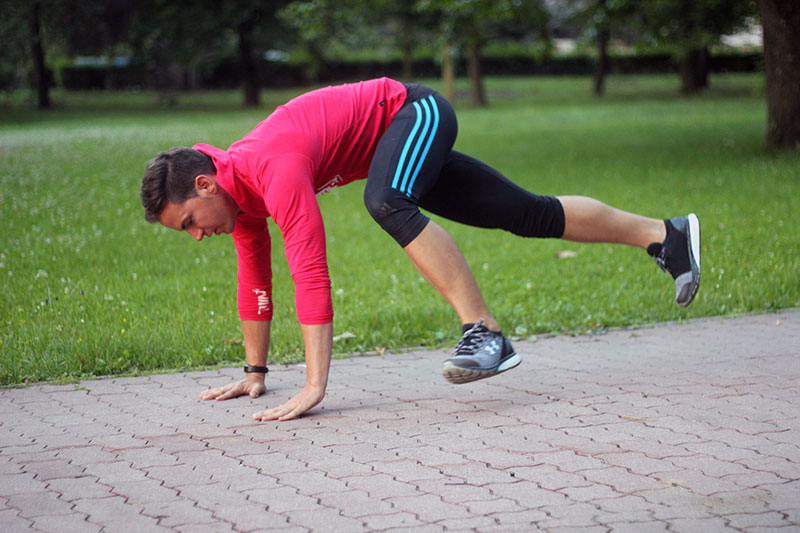Are you looking for a crisp HIIT workout?
Then you’ve come to the right place.
I shot a HIIT workout video for you right in Lake Faak.
In the lake? Don’t worry, you don’t have to swim.
You will also get a lot of useful information on the topic of high-intensity interval training and a lot of other HIIT workout variants.
What is a HIIT workout?
Let’s start at the beginning …
HIIT stands for “High Intensity Inverval Training” or in German “High Intensity Interval Training”.
The most important characteristic of a HIIT workout is that there is a work and a break time. That means, workout and break alternate. While you are practicing, you also go very high intensities, so that you then also need the short break.
You can find out more about HIIT training in this article from me: How to train more with less time.
Highly intensive means that you train with around 90 percent of your maximum heart rate. (If you are just at the beginning, then less). To put it simply: You should get your pulse up a lot so that your breathing rate is increased very much and normal conversations are no longer really possible.

For me, a HIIT workout with bodyweight exercises usually also has the so-called “Montain Climber” or “Climber” among the exercises.
interval training means that you combine these very strenuous training sections with much easier time units for recovery. The intensive phases last between 15 and 60 seconds, the recovery phase in low intensity can only be half as long to three times as long. Then you start again. Usually 8 to 12 of these intervals are completed in a row.
Not that difficult to understand, is it?
Since these are high-intensity workouts, beginners should exercise particular caution .
A check at the doctor (pay attention to my advice when training) definitely can’t hurt. He should then give you the clearance to exercise (with maximum heart rate).
Cool fact for everyone for whom time is precious: A HIIT workout normally only lasts between 10 and 30 minutes.
Nevertheless, they are more effective than simple moderate endurance training – even if you do your normal cardio training for twice the time. However, you should only do HIIT 2-3 times a week. So that your body has enough time to regenerate from the hard units. In addition, other training sessions (e.g. strength training or moderate cardio training) can be on the schedule.
40/20 HIIT workout (Faaker See)
I’ve chosen a very special location for this HIIT workout.
I’m standing on a floating platform directly in Lake Faak. There we do 10 exercises together. We always practice 40 seconds (in the first interval I stopped a little too early, don’t let that confuse you) and take a 20-second break. In total, the HIIT workout takes 10 minutes.
It is an activating HIIT workout because the intensity of the exercises increases within the 10 minutes, so they become more and more strenuous for you. So let’s go, join in!
If you want a more detailed explanation of the exercises, scroll down a little.
1. Torso rotation
The first exercise is important for the mobility of your active spine, especially in the chest area.
Stand shoulder-width apart, bend your knees a little and then rotate your upper body. Keep your hips stable, they won’t turn!
2. Good Mornings
Stand shoulder-width apart and knees slightly bent.
Then you walk forward with your upper body stretched until you are roughly parallel to the floor. Your legs can stay slightly bent.
Then up again.
3. Handstand Kick Ups & Holds
What?
Right into the handstand?
Well, you can do it with the help of a wall if you can’t stand free yet. But it is also enough if you kick yourself up again and again (even if you fall over again).
If that doesn’t work either and you can’t do the free handstand yet (on the floating island that was a challenge for me too), do a frog handstand. To do this, you support your arms on your knees. The hands hold the entire weight as in a handstand.
4. Shoulder Taps
Get into the starting push-up position and spread your legs.
Then tap alternately with your left hand on your right shoulder and vice versa.
Make sure that your hips remain stable, i.e. not move.
5. Awakening Dog
Go inside the looking down dog first and “sniff” from there along the floor up to the top of the looking up dog.
Then do the same movement in reverse (be careful, difficult!). If you can’t do that yet, go back into the downward facing dog without “sniffing”.
6. Cassowary Kick
In this exercise you take a wide straddle and reach close to the center of the body with your hands on the floor.
Then you thread one leg between the arm and the leg on the other side and back to the starting position.
Then you switch sides.
7. Bridge Kicks
Go back on the floor so that only your feet and hands are on the floor.
Then lift your pelvis and stay up so that your thighs and torso are in a line parallel to the floor.
Then alternately lift / kick your legs upwards so that the lower leg also joins the extension of the thigh and body.
8. Jumping Squats
This plyometric squat variant will challenge you to the full.
Stand about shoulder width apart and with your back straight, go down as far as you can.
Then jump up explosively.
9. Climbers
Get into the starting push-up position.
Then you jump alternately with one leg forward to the respective hand.
10. Sprawls (squat-stretch-jump)
Reach the ground from a standing position in front of you, then jump backwards.
Then you jump forward again and finally stretch up.
More HIIT workout variants
There are countless variations of high-intensity interval training.
I would like to introduce you to a few that can be easily implemented with bodyweight exercises.
Tabata Training
20 seconds workout, 10 seconds break. This is Tabata. The whole thing then 8 times in a row.
The easiest way to do this is with exercises like burpees or the like.
Sprints (at not quite full speed) can also be considered as a training variant.
Tubulence method
This training method combines strength and endurance training into a damn effective, but also strenuous workout.
You first do a difficult strengthening exercise of which you can only manage 8 repetitions (for example, pistol squats, handstand push-ups or the like or, depending on your level of ability, simple push-ups). Then immediately afterwards a minute of cardio exercise such as burpees, sprawls or climbers.
You try to hold out for 20 to 30 minutes.
Little method
The Little method involves a high-intensity interval of 60 seconds followed by 75 seconds of low intensity.
A total of 12 repetitions and thus 27 minutes of training (without warm-up) are on the program.
Wingate protocol
The Wingate protocol includes 4-6 intervals, each with 30 seconds of high-intensity exercise and 1 to 2 minutes of recovery.
Either running, cycling on the ergometer or strengthening exercises without equipment can be used.
You can find many more HIIT workouts – some with videos – to join in on my blog:
Scientific 7-Minute Workout
This HIIT workout made it into the New York Times and is also a way to do high-intensity interval training.
There are 12 different exercises with your own body weight. You perform each exercise for 30 seconds, followed by a 10-second recovery period.
There are other methods like the challenge method, the 50/10 HIIT, circular intervals, etc. They all have one thing in common high-intensity stress phases alternate with recovery phases of low intensity. You can find many of these training methods in my P.A.T. Bodyweight training complete package.







